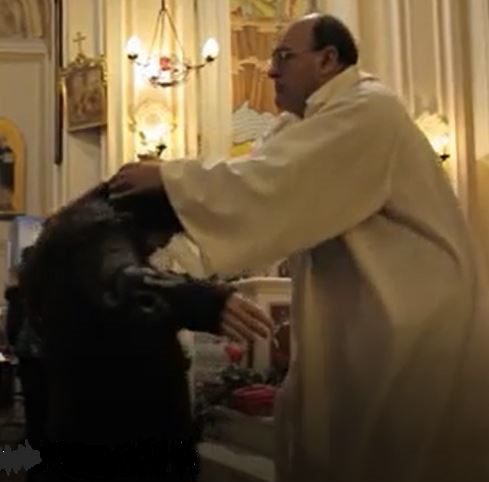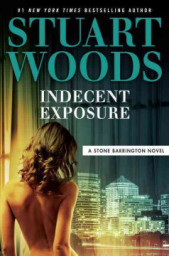Premiering on October 26 in the UK and Europe, Deliver Us is a documentary on exorcists in Italy trying to keep up with an increasing global demand for church-sanctioned exorcism.

The Telegraph‘s movie reviewer Rachel Ray gave Deliver Us 4 out of 5 stars. She writes:
While the Catholic Church keeps no central database for the number of people asking for exorcism or the number of times it is performed, Italians are reported to seek the Rite on a more regular basis than dental appointments….
In Rome and Milan, the number of church appointed priest-exorcists has grown from six to 12, and the Church has set up an emergency call centre. In the US, over the past decade, the number of priest-exorcists has more than quadrupled from 12 to 50. As noted American exorcist, Father Vincent Lampert of the Archdiocese of Indianapolis points out, it is not the Church that is increasing the demand for exorcists, it is people.
Father Lampert would be supported in that opinion by this film, which shows people travelling from across Sicily to [80-year-old Franciscan] Father Cataldo [Migliazzo]’s mass of liberation in Palermo every Tuesday, and for private sessions with the exorcist. But Father Cataldo will only admit so many people into the church on a given day and many are turned away.
During the service, people scream, moan, and cry. A young man writhes on the floor spitting. An elderly woman who is led out of the church seems to be speaking in tongues. Another woman screams: “I’ll take her to Hell!”
The dilemma that any exorcist faces is deciding whether a person’s condition is the result of psychological problems or demonic activity. This is discernment, the first step in the Rite of Exorcism and in the US at least might involve examination reports from a team of psychologists or psychiatrists. This grey area of mental versus spiritual is clearly what interests the film’s director, Federica Di Giacomo. She observes: “My first aim was to find stories for a film about obsessions, a sort of a journey through mental addictions.” Perhaps unbeknown to Miss Di Giacomo when she began the project was that obsession can be a form of demonic affliction.
The demonic-weary Father Cataldo conducts discernment in his own way. To the parents of a boy who spits at his teachers and makes fun of his father, the priest says he’s a good boy, calm, take him back to the psychologist. But for a woman who becomes increasingly agitated by the recitation of prayer, Father Cataldo tries to deliver her from Satan as she is held to the floor growling and screaming.
Another woman seems to be suffering from depression. And the priest listens patiently to a young man who believes his life-threatening bike accident may have been the result of his lapsed spiritual state. Regardless of what the exorcist thinks though, all of these sufferers seem to believe that church intervention can cure what ails them.
So many people want Father Cataldo’s services that he even conducts deliverance via mobile phone. But the documentary is not shallow. Miss Di Giacomo gives us a more in-depth look into cases that may be possession, attachment, vexation, or oppression – all varying degrees of demonic influence. A number of the film’s subjects have been having exorcisms on a routine basis over a period of years for their conditions.
A young woman, Giulia, dabbles in the occult and consults mediums. She has great difficulty being in a church without screaming and acting out. As Father Cataldo prays with her, her eyes roll back, exposing the whites. She writhes on the church floor and screams at the priest “you’ll burn in hell with me”. But even after the exorcism seems to change her looks and demeanor, by the end of the film she still cannot give up the mediums and resists returning for more sessions in the church where she is visibly uncomfortable.
Two sisters relate a history of molestation and abuse from their mother’s boyfriend. Now, in middle age, one of the sisters cannot function normally and her marriage is failing. She growls and crawls under tables in the church as the exorcism proceeds. Like Giulia, her case is unresolved. An attractive middle-aged woman loses control of her limbs, falling down, when she enters a church. She can find no psychological or physical explanation from physicians after years of trying. And countless MRIs and other tests.
And perhaps one of the saddest cases is a young man in Palermo, addicted to cocaine, who is shunned by his family, and fears he will be committed to an institution without Father Cataldo’s help. Filmed in the nightspots of Palermo, he laments: “Society doesn’t let you get better or run away from certain things.”
One cannot help but be in sturdy, hard-working Father Cataldo’s corner in this spiritual fight. “Being an exorcist is an exhausting job,” he notes with resignation. Exorcist-priests are appointed by their Bishops often with little choice in whether to take on the job. And for viewers who have no spiritual beliefs, the question might be asked why these sufferers, in increasing numbers, are seeking relief from the Church.
Here’s a clip from the documentary. Pay special attention at the 0:42 mark.
See also:
- Psychiatrist says demonic possession is real
- Exorcists: Demon-possessed ‘can take on the look of a reptile or snake’
- Exorcist warns about ’50 Shades of Grey’
- Sunday Devotional: A Prayer for Exorcism
~Eowyn
Advertisements Rate this:Share this:




